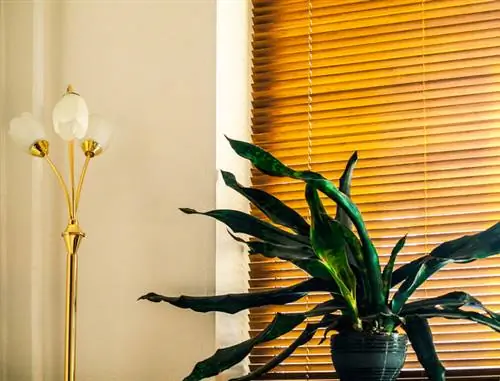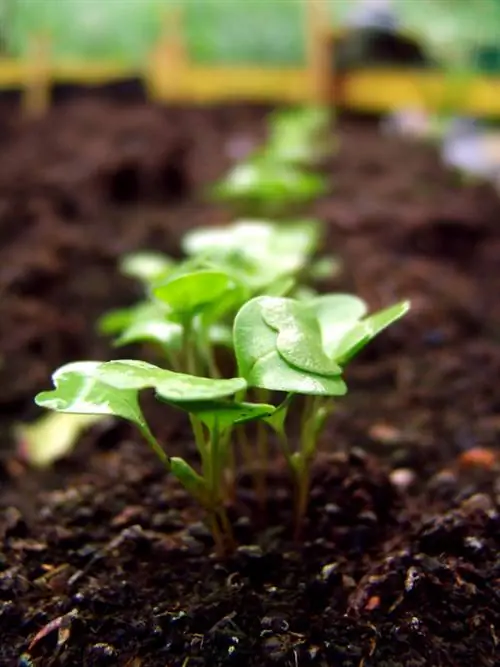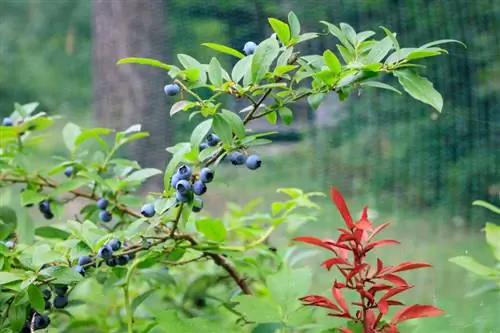- Author admin [email protected].
- Public 2023-12-16 16:46.
- Last modified 2025-01-23 11:19.
Mulching is considered an important measure in the garden to promote plant growth. It can be used on lawns and in beds, although the material should be carefully selected. If done correctly, visible results will be achieved after a short time.
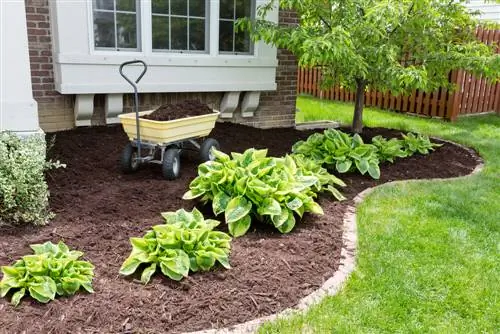
What is mulching and how to do it correctly?
Mulching on lawns and in beds protects the soil and promotes the growth of moisture-loving plants in semi-shady and shady locations. Heat-loving species should not be mulched. Organic waste products such as slightly dried clippings are suitable as mulching material.
What is mulching?
The term mulching is derived from the Middle High German word mul, which describes the decaying earth. Mulching is also known as flailing and means covering bare soil with organic material that has not yet decayed. In agriculture, the mowing and mulching work steps are completed in one go. The clippings are shredded directly and remain on the surface. Mulching with grass clippings is a common practice in private gardens to promote plant growth.
Advantages:
- Konstanz: Soil stays cool longer in hot weather and retains the daytime heat better in the evening
- Yield: extended growing season and better harvest
- Protection: Soil is protected from drying out during heat periods and siltation during heavy rain
- Nutrients: Mulch layer decomposes and acts as an organic fertilizer
- Weed inhibition: Seeds of unwanted weeds do not receive enough light to grow uncontrollably
Nature as a role model
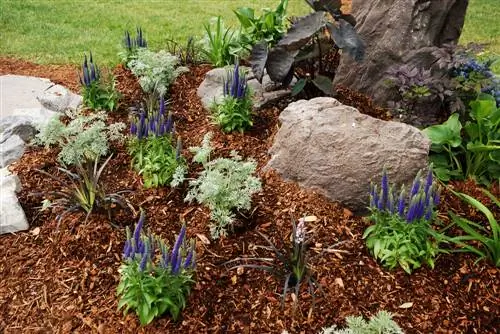
A layer of mulch simulates a natural forest floor
Bare soils do not occur in nature. As soon as an area falls fallow, the first pioneer plants establish themselves. In the forest, the soil is protected by mosses, leaves and herbs. This layer of litter provides a habitat for numerous insects and fungi, which keep the functions of the ecosystem running. When you mulch the bed, tree disc or lawn, you ensure effective protection of the soil structure and its living creatures.
Important when mulching:
- Spread mulching material only on loose soil
- Let green and juicy cuttings dry a little to prevent snails
- apply thinly, no more than two centimeters thick
Equipment for mulching mowing
For several years there have been models of lawn mowers that reduce the amount of work. You cut the grass and shred it in the same step. The cuttings are no longer collected in a collecting basket, but remain lying directly on the lawn. The different construction methods each have their advantages and disadvantages. The size and location of the garden are decisive for the choice.
| Advantages | Disadvantages | |
|---|---|---|
| Battery lawn mower with mulching function | flexible use, low noise, low maintenance | usually not suitable for large areas |
| Petrol lawnmower with mulching function | better performance than battery-powered devices | loud activity |
| Reel mower | clean cut, mostly hand-operated | fails in tall grass |
When does a mulching mower become worthwhile?
Since many models are expensive, they are not suitable for small gardens. From an area of 200 square meters, the advantages of lawn mowers with a mulching function come into play. They make the maintenance of these areas easier. In smaller gardens, it is worth retrofitting your existing lawnmower with a mulching mowing set.
Is mulching possible with a normal lawnmower?
Most devices are not suitable for mulching. When you mulch with a conventional lawn mower, very coarse material is left behind on the area. It takes longer for the soil organisms to decompose the grass clippings. The clippings are often distributed unevenly over the area, which is why moss can form in places. In addition, the exchange of gases between air and soil is impaired.
Mulching: when is the best time?
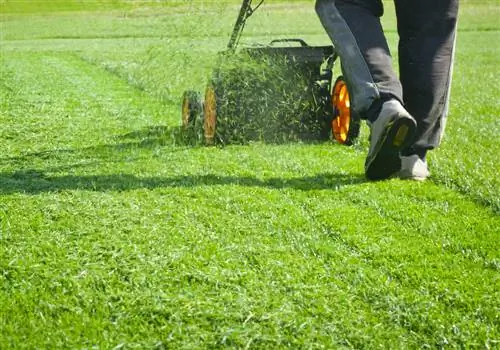
Lawn can be mulched several times a year
When and how often you carry out this maintenance measure depends on the respective area. For best results, you should mulch regularly from spring to autumn. Lawns can be mown and mulched for the first time as soon as the grass has grown about ten centimeters high. Later you can let the grass grow to a cutting height of between six and eight centimeters.
Make sure the grass is as dry as possible. You should not mow the lawn after rainy days to prevent the clippings from clumping together. Beds should not be mulched immediately after sowing the seeds, as this will shade the seeds and prevent them from germinating. Before mulching for the first time, wait until the seedlings have grown a few centimeters tall.
Which plants can I mulch?
Basically, you can provide everything that grows in the garden with a layer of mulch. When mulching the meadow you have to pay attention to different aspects than when covering beds. The pasture for horses can also be mulched. However, not every plant will thank you with lush growth if the soil is covered with organic material. Mulching tomatoes means increased crop yield. Special conditions apply when mulching roses.
Most plants like a layer of mulch - with the exception of heat-loving plants.
Perennial beds and grasses in the ornamental garden
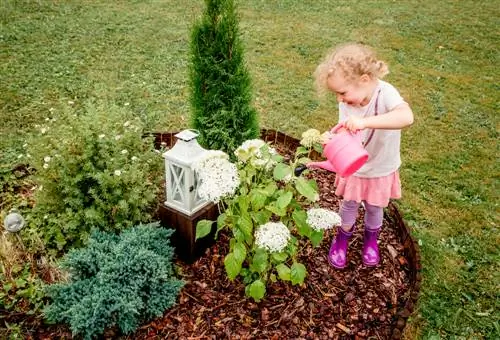
Mulch protects the soil and also looks pretty
While the meadow can be mulched with mown material, you have to use other material for ornamental plants. Every plant has different demands on the soil and it also tolerates the different mulching materials differently. As a general rule, heavy floors should be covered with light material. Choose the mulch so that its grain size is slightly smaller than the grain size of the substrate. This prevents the soil from compacting and gives the vegetation stability.
Ornamental plants and their preferences:
- Rhododendron: Fallen leaves, bark mulch or shredded branches and twigs keep the pH value constantly low
- Bamboo: Pine bark, shavings, leaves or straw maintain soil moisture
- Perennials: Bark mulch is considered an all-rounder
Beds in the kitchen garden
Dried comfrey leaves and nettles without flower heads are ideal if you want to mulch tomatoes. Cucumbers and beans can also be mulched with lush growing herbs. Because of the high rate of decomposition, you will need to mulch the vegetable patch more often. Flat peas, buckwheat and vetches provide perfect mulching material for potatoes because they are rich in nutrients and mainly supply nitrogen to the soil.
Excursus
Mulching corn stubble
Mulching is particularly important on arable land. If the remaining crop residue from the corn is shredded, the material can be better incorporated into the substrate during subsequent tillage. This measure ensures that the wintering quarters of the dreaded corn borer are destroyed. Its caterpillars retreat into the hollow stems to survive the cold season until spring. However, this method is viewed ambivalently because other insects also find an important place to retreat in the corn stubble.
Plants of dry and warm locations
Many ornamental plants or herbs from Mediterranean regions that grow in sunny locations prefer dry and warm conditions. Such plants should not be mulched with straw, bark or green material. A layer of gravel is suitable as a ground cover for lavender. The stones store heat and are permeable to water and air.
Fruit and berry bushes

Strawberries particularly benefit from straw
Straw is not only suitable for covering paths in the garden, but also for mulching raspberries, currants or blackberries. The loose material ensures good floor ventilation and acts as optimal protection. When you mulch strawberries, you not only benefit from the improved soil properties. The ripening fruits remain on the straw protected from wet soil and are less susceptible to gray mold and snail damage.
Shrubs and trees
Fruit trees in the orchard are grateful for a layer of mulch. Mulching the tree disc not only helps the soil to dry out less during the hot summer months. The mulch layer acts as a visual barrier and thus protects the tree from mechanical damage, which often occurs during harvesting work. You can use grass clippings as well as bark mulch or straw as material. Bark mulch is less suitable for mulching roses because the shrubs rely on optimal soil aeration. Provide the ornamental plants with compost in autumn.

Materials for mulching
Organic materials have different effects. Their decomposition rate depends on factors such as structure or moisture content. Mulching with straw is a popular option used on berry bushes. In principle, you can reuse any organic waste from your garden. However, you should pay attention to the needs of the respective plant.
| Application | Notes | |
|---|---|---|
| Grass clippings | for almost all plants | can be mixed with wood chips for better ventilation |
| Leaves | Forest plants, vegetable patch, berry bushes | Autumn leaves are poor in nutrients |
| Sheep wool | Heavy eaters | releases nitrogen over a long period of time |
| Stinging nettles | Beds, ornamental plants, fruit bushes | rotts quickly |
| Bark mulch | Perennials in partial shade and shade, grasses and ferns | Use freshly sieved, methanol and sulfur smells indicate putrefactive processes |
| Straw | Vegetable and orchard | fixes nitrogen in the soil, which is why additional fertilization is necessary |
Mulching or mowing?
Whether you mow or mulch your lawn depends on your personal preferences on the one hand and on your garden and the equipment you have on the other. From an ecological point of view, mulching is better because you do not remove any nutrients from the lawn and ensure a natural cycle. However, this method is more time-consuming as it has to be done more frequently. In particularly heavy or very sandy soils and in regions with high rainfall, mowing with subsequent composting of the clippings makes more sense.
Disadvantages of mulching:
- too thick a layer attracts snails and voles
- prevents soil warming in spring and autumn
- Harvest mites feel particularly comfortable in mulch
- some mulches remove nitrogen from the soil
How to mulch properly
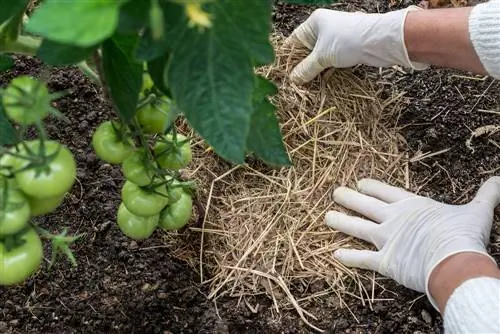
Mulch protects against weed growth
While mulching a lawn is easy, beds and shrubs require a little more attention. Done correctly, mulching helps against moss and weeds.
Soil preparations
Carefully roam the substrate in the bed or under bushes with a rake. This loosens unwanted weeds and gives the top layer of soil fresh air. Weeds do not need to be disposed of in the compost if they have not yet formed fruit. Their roots dry out quickly on the surface of the soil, so the herbs also serve as a good layer of mulch.
Tip
You can protect young plants during this work by placing small pots over them.
Spread mulch
Spread the organic material over the ground and spread it on large beds with a broom and under bushes by hand. You should maintain a certain distance from the stems of the plants so that the moist mulch layer does not cause rotting processes at the base of the plants. A few centimeters are enough to ensure that the plant is sufficiently ventilated. The thickness of the layer should be about five centimeters. More frequent and economical use of the material is better than one-time mulching in large quantities.
Check occasionally
The mulched area can then be left to its own devices. Since some unwanted plants always grow through the mulch layer, you should pluck them out regularly. They can then be left lying on the surface so that the soil organisms can release their nutrients. The next layer of mulch is due as soon as the old material has almost completely decomposed.
Alternative mulching materials
Trade offers alternatives to the common mulching substrates that are used in the garden. Such materials prove to be more effective in certain situations compared to organic waste. These variants are less suitable for long-term use, and not just for cost reasons.
Coconut mats
They act as air-permeable bed covers and protect the soil from frost, heat and erosion. Shallow-rooted ornamental and useful shrubs such as honeysuckle and honeysuckle or elderberry and blueberries benefit from coconut mats. These are three to five centimeters thick and consist of unusable coconut fibers. They are held together by organic natural rubber and can be easily cut with scissors. A coconut mat lasts two to three years.
Tip
Coconut mats are also suitable as an insulating layer for plant pots in winter. Cover the substrate with the material and place the pot on a piece of coconut mat.
Foil, fleece or paper
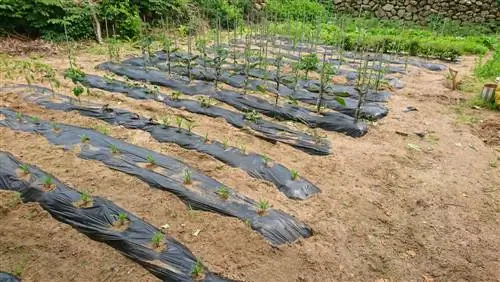
Plastic films protect against weeds and warm the ground, but they are not very environmentally friendly and are not visually enriching
Fabric made of dark plastic fibers ensure that the soil warms up quickly when the sun shines on it. The soil underneath remains moist for a long time. Such covers are particularly suitable for weedy areas whose vegetation automatically dies off after a long period of time. Since the material does not decompose and floor ventilation is limited, plastic mats are not suitable for long-term use.
As an alternative, films made from corn starch or paper, which are biodegradable, are recommended. Their decomposition rate is high, so they need to be renewed regularly. The soil warms up more than under mulches made from straw, compost or grass clippings. Therefore, heat-loving plants such as pumpkin or cucumber feel particularly comfortable with this type of ground cover.
Frequently asked questions
How does mulching with a mulching mower work?
As soon as the lawn has grown ten centimeters high, you can mow it down with the mulching mower. If the lawn is dry, the speed is set to high. Drive over the lawn in even paths so that all blades of grass are covered. The strips can overlap at the edge of the surface. If the lawn is higher than ten centimeters, you should shorten it by a maximum of a third. The next mowing can be carried out the next day to achieve the optimal cutting height of three to five centimeters.
When should I mulch the lawn?
Mulching mowers should only be used when the grass and soil are well dry. After long periods of rainfall, waiting for the optimal time can become a race against grass growth. If you can no longer delay mowing, set the cutting height relatively high and work your way forward slowly. This will keep the risk of clumping small. Clean the blades thoroughly after work so that plant residues do not dry in the mower.
Why should I mulch my lawn?
If the clippings remain on the surface and are not removed, a natural nutrient cycle is created. Soil organisms decompose the plant material so that the nutrients are returned to the soil. The thin layer also protects against excessive sunlight and prevents overheating. This allows the lawn to develop better.
How often do you have to mow mulch?
In spring you should drive over the lawn with the mulching mower once a week. During this period of heavy rainfall, grass growth is very pronounced, which is further promoted by the improved nutrient supply. The shorter the intervals between mowing dates, the better the lawn will develop. Adjust the frequency according to the growth of the grasses. This decreases during the dry summer period, allowing you to extend the intervals.
How does mulching change the appearance of the lawn?
In an area that is not mulched, a species shift can occur if the existing grasses do not receive sufficient amounts of nutrients. Lawn mixtures consist predominantly of meadow panicle. Due to a lack of nutrients, this species is pushed back by other grasses that can survive better in conditions with fewer nutrients. Red fescue and bentgrass dominate the picture. This reduces the resilience of the lawn and increases the risk of matting.
How can I make my own mulch?
Since mulch consists of organic residues, you can make your own suitable mixture to cover the ground. Garden waste of any kind is perfect. Shred clippings from hedges and trees and mix them with small amounts of lawn clippings or straw. The material is well suited for berry bushes. In autumn you can collect fallen leaves and use them as mulching material. If you have problems with snails, you should use mulch made from chopped reeds. Crushed herbs with an intense scent have a deterrent effect on various plant pests.


